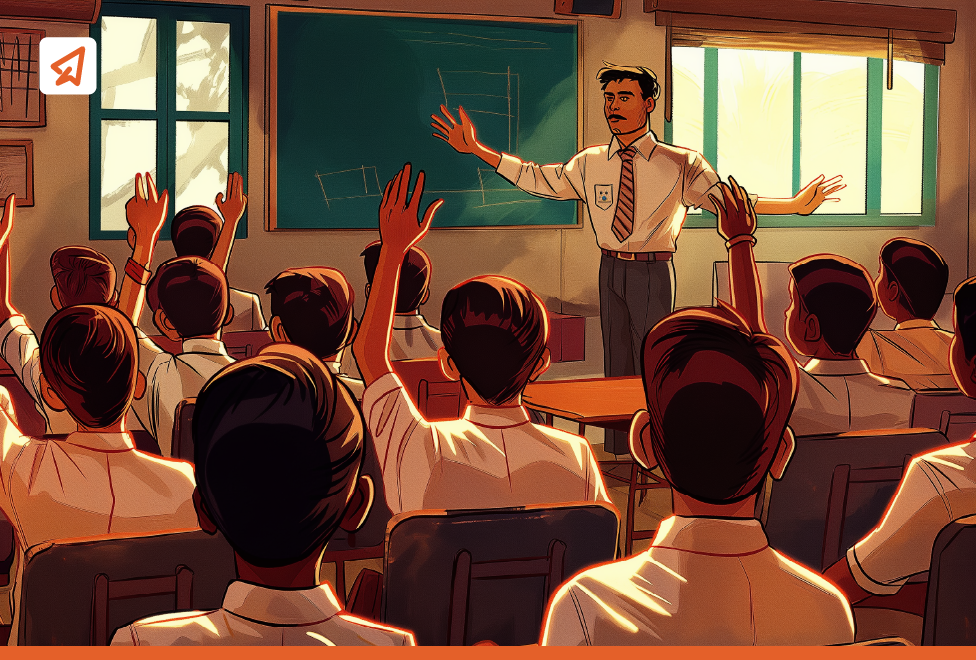Addressing Teachers’ Concerns About AI for Their Students

Technology is changing the way education is perceived today. About 44% of teachers in India are rightfully alarmed about this impacting the teaching and learning experience.
There are plenty of concerns teachers have about AI, and it is time to address them and put their worries to an end.
Problems with AI in Education & Solutions for Teachers’ Concerns About AI
With AI becoming more advanced and accessible, educators are understandably worried about its impact on learning. Let’s break down some key concerns teachers have and explore practical ways to address them.
Concern #1: Maintaining Academic Integrity
The first concern teachers have about AI-powered tools is that they make it easier than ever for students to generate essays, complete assignments, and even answer complex questions without truly engaging with the material.
This raises serious concerns about plagiarism. Since AI-generated content can sometimes bypass traditional plagiarism checkers, detecting academic dishonesty has become trickier for educators.
Solution:
- Use AI detection tools to identify AI-generated content in student work.
- Focus on creativity, personal reflection, and hands-on projects instead of generic essay-style tasks.
- Introduce process-based learning, where students submit drafts and show progress over time.
- Design assignments that require unique perspectives, real-world examples, and personal insights rather than reiterated information.
- Educate students about academic integrity and responsible AI use so they understand why honesty matters.
- Incorporate more in-class discussions, presentations, and debates to reduce over-reliance on AI for written work.
Concern #2: Reducing Demand for Human Teachers
Another concern teachers have about AI is that many worry it could eventually replace them. While it can provide instant feedback and automate repetitive tasks, it lacks the emotional intelligence, adaptability, and personal connection that human teachers bring to the classroom.
Teaching is more than just delivering information. It is about inspiring, mentoring, and understanding students on a deeper level, something AI simply cannot replicate.
Solution:
- Treat AI as a support tool, not a replacement. It can assist with tasks, but the role of a teacher remains irreplaceable.
- Highlight the importance of human interaction in education as students need empathy, guidance, and motivation, which only teachers can provide.
- Use AI to streamline administrative work (e.g., grading multiple-choice tests, tracking attendance) so teachers can focus more on student engagement and personalised learning.
Concern #3: Weakening the Student-Teacher Bond
If students turn to AI for all their learning needs, they might miss out on valuable discussions, mentorship, and the emotional support that only a teacher can provide.
A strong student-teacher bond is essential for motivation, confidence, and deeper learning, something AI alone cannot offer.
Solution:
- Maintain regular discussions, feedback sessions, and one-on-one mentoring to foster personal connections.
- Leverage AI to enhance engagement and use it for interactive learning, but keep teachers at the centre of the experience.
Empower teachers with the strength of AI while keeping real connections alive. Explore Extramarks for Teachers for a redefined tutoring experience!
Learn MoreConcern #4: Student’s Reliance on Technology
A real concern teachers have about AI is that students might stop thinking of solutions by themselves. If they rely too much on AI, their ability to solve problems independently and think critically could take a hit.
Instead of developing essential skills like analysis and reasoning, they might just copy AI-generated responses without fully understanding them.
Solution:
- Strike a balance between AI and traditional learning by mixing tech-driven tools with hands-on problem-solving and discussions.
- Make students explain and justify AI-generated answers to ensure they understand the material, not just copy-paste responses.
- Design assignments that prioritise creativity, independent thought, and deep analysis rather than just fact-based answers.
- Let students use AI tools mainly for research and brainstorming for their assignments, instead of using them as a tool for content creation.
Concern #5: Introducing Misinformation and Biases
AI learns from the vast pool of data fed to it, which means it can sometimes pick up biases, present misleading information, or even favour certain learning styles.
This concern teachers have about AI usage is valid because if students or even educators rely too heavily on AI without questioning its output, it could lead to misinformation, unfair grading, and a distorted understanding of topics.
Solution:
- Teach students how to think critically and verify sources rather than taking AI-generated information at face value.
- Regularly review AI-driven assessments to ensure they are unbiased, transparent, and fair for all students.
- Use AI tools that are ethically developed and vetted for accuracy to minimise misinformation.
- Encourage students to cross-check AI-generated content with multiple reliable sources before accepting it as fact.
- Offer diverse assessment formats to cater to different learning styles, reducing the risk of AI favouring one approach over another.
Concern #6: Losing Research and Writing Skills
With AI tools capable of generating essays and summaries in seconds, teachers worry that students might skip the hard work of researching, structuring arguments, and refining their writing skills.
Too much reliance on AI can make them risk losing essential skills like analysing sources, forming original thoughts, and effectively communicating ideas. Over time, this could weaken their ability to write clearly and think critically.
Solution:
- Require students to manually research topics and cite credible sources to build strong research habits.
- Implement structured writing exercises where AI use is restricted, ensuring students develop their own writing style.
- Introduce assessments on a student’s ability to synthesise information, like understanding, analysing, and presenting ideas rather than just generating content.
Concern #7: Reducing Student Engagement
If AI simply hands over answers, students might become passive learners, losing interest and motivation. This is a major AI-related concern for teachers.
Learning is not just about consuming information; it is about curiosity, problem-solving, and hands-on experience. When AI is used without interaction, it can make learning feel disengaging, turning students into spectators rather than active participants.
Solution:
- Implement interactive AI-based experiences that encourage exploration and critical thinking.
- Use gamification, project-based learning, and real-world problem-solving to make lessons more dynamic and enjoyable.
- Incorporate hands-on activities that require students to actively engage, experiment, and apply their knowledge.
Don’t let AI affect your student engagement.
Access Extramarks’ interactive digital content for a highly immersive learning experience!
Learn MoreConcern #8: Limiting Peer Interactions
Extensive AI reliance can affect a student’s valuable opportunity to collaborate, communicate, and develop social skills. When AI replaces traditional group activities, students may struggle with interpersonal engagement, problem-solving, and real-world collaboration, which is a concerning AI-related issue for teachers.
Solution:
- Prioritise group projects and discussions alongside AI-driven learning to encourage teamwork.
- Assign tasks that require students to collaborate, debate, and engage in meaningful conversations.
- Limit AI use in activities where direct peer interaction is essential, such as brainstorming sessions and role-playing exercises.
Concern #9: Causing Mental Fatigue
Spending long hours staring at screens can mentally exhaust students, making it harder for them to focus and retain information. While AI tools can enhance learning, excessive screen time can lead to fatigue, reduced attention spans, and even physical strain like eye discomfort.
Solution:
- Set clear screen time limits for AI-based learning to avoid overuse.
- Incorporate offline activities like reading, writing, and hands-on projects to create a healthy tech balance.
- Encourage outdoor learning and real-world experiences to keep students active and engaged beyond the screen.
Embracing AI as a Tool, Not a Replacement!
While teachers’ concerns about AI are valid, we should not forget that technology in education is here to stay. So, rather than viewing it as a challenge, leverage it as a powerful tool to enhance teaching and learning.
For educators looking to harness AI without facing any of the above concerns, Extramarks provides a well-rounded solution. With interactive learning tools, AI-driven insights, and teacher-centric features, we empower educators to make the most of AI while keeping the human connection at the heart of education.
Explore our innovative AI-based solutions designed to enhance teaching and learning experiences.
Get Started NowLast Updated on April 28, 2025
Reviewed by

Priya Kapoor | AVP - Academics
Priya Kapoor is an accomplished education professional with over 18 years of experience across diverse fields, including eLearning, digital and print publishing, instructional design, and content strategy. As the AVP – Academics at Extramarks, she leads academic teams in creating tailored educational solutions, ensuring alignment with varied curricula across national and international platforms...read more.









